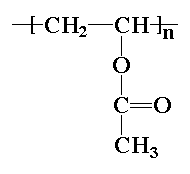
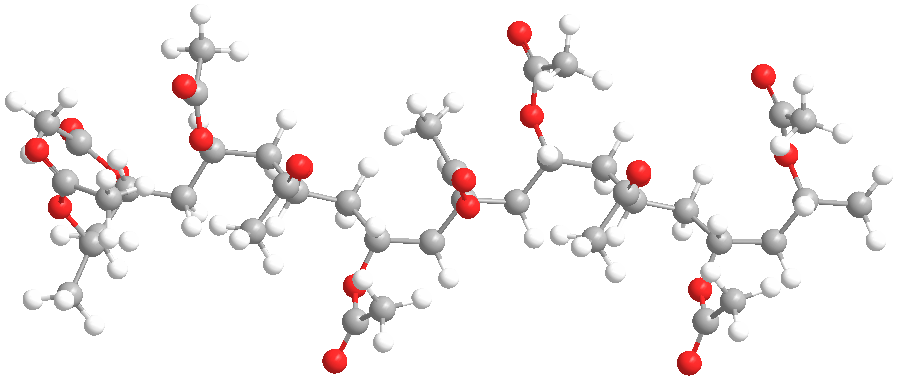 The model above is an image of the pdb model you can view
The model above is an image of the pdb model you can view by clicking here or you can just click on the image itself.
Either way, be sure to close the new window that opens up
with the 3D model in it when you are ready to come back here.
For Poly(vinyl alcohol) at a glance, click here!
Poly(vinyl acetate), or PVA for short, is one of those low-profile behind-the-scenes polymers. It isn't blatantly obvious where it's found, as is the case with polyethylene or polystyrene. PVA likes to hide. But it's everywhere, if you're willing to look for it. It's a polymer that rewards one who is willing to look beyond the surface. One place PVA can be found hiding is between two pieces of wood that are glued together. PVA is used to make wood glues, as well as other adhesives. Paper and textiles often have coatings made of PVA and other ingredients to make them shiny.
PVA is a vinyl polymer, as if you couldn't guess from the name. It's made by free radical vinyl polymerization of the monomer vinyl acetate.
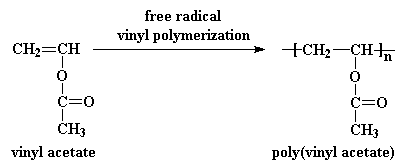
This is what the monomer looks like in 3-D:
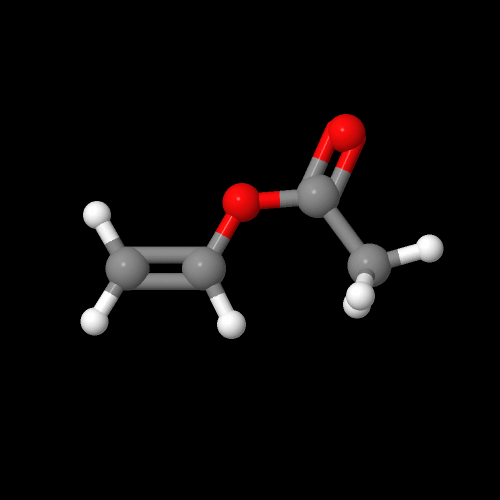
The model above is an image of the pdb model you can view
by clicking here or you can just click on the image itself.
Either way, be sure to close the new window that opens up
with the 3D model in it when you are ready to come back here.
One interesting place where PVA likes to hide is in paint cans. So what is PVA doing hiding in your paint? PVA is the latex in acrylic latex paint. So what does that mean? Let me explain. Before PVA can hide in a can of paint, we have to react it with NaOH and methanol like this:
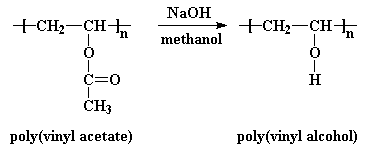
When we do this we clip off all those acetate groups to end up with another polymer, poly(vinyl alcohol). But for paint we don't really want to clip all of the acetate groups. We can control this reaction so that when we're done we still have about 20% of the acetate groups left on the polymer. what we have then is a copolymer of poly(vinyl alcohol) and poly(vinyl acetate) called poly(vinyl alcohol-co-vinyl acetate), appropriately enough. It's a random copolymer that looks like poly(vinyl alcohol), except with vinyl acetate repeat unit every now and then, like this:

But why do we want to do this? It has to do with how acrylic paints work. Acrylic paints contain poly(methyl methacrylate) in a solvent which evaporates as the paint dries. Its structure is similar to PVA, but it's different. Look closely. Can you see the differences?

Poly(methyl methacrylate), or PMMA, is a hard, tough, and shiny plastic, and when it forms in the wet paint, it makes the paint surface, hard, tough and shiny. This is good. We want paint to do this. But there's a problem. PMMA is hydrophobic. It doesn't dissolve in water, and a lot of paints are water based.
This is where poly(vinyl alcohol-co-vinyl acetate) comes to the rescue. You see, this copolymer has an identity crisis. The alcohol groups are hydrophilic. They love water, and want to dissolve in it. But the acetate groups are hydrophobic. They hate water and don't want to dissolve in it. So when you put the copolymer in water, it forms into a ball. The alcohol repeat units are on the outside of this ball, happily embracing the water, while the acetate groups are on the inside of the ball, hiding from it.
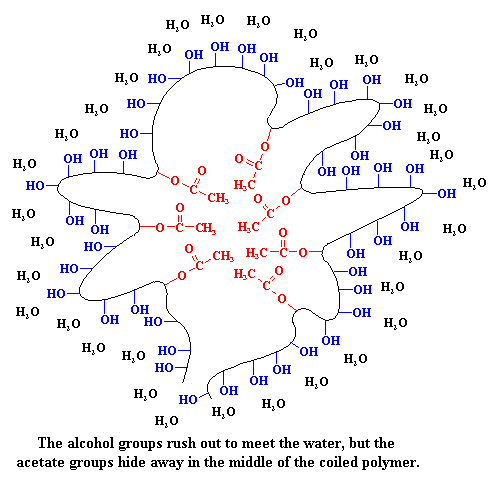
Now ask yourself this question. If you were a molecule of PMMA, and as a PMMA molecule you hated water, where would you go? Would you go out into the water, or would you go into the inside of that coiled polymer, away from the water? You'd go to the inside of the coil of course! And that's just what the real PMMA does. The PMMA hides in the hydrophobic center of the coiled polymer. By doing this, it can stay suspended in water based paints! A suspension of an insoluble substance, like PMMA, held in suspension by being wrapped in another kind of molecule, like our copolymer, is what we call a latex. That's where we get the name latex paint.
Slime: Where Would We Be Without It?
Find out more about the molecular basis and how to make this fascinating marvel of polymer science! Fun to make and fun to play with, even for big kids like us... Click on the name above or here.

|
Return to Level Two Directory |

|
Return to Macrogalleria Directory |